Sustainable Operations and Destinations Report - MGMT2, Semester 1
VerifiedAdded on 2022/10/09
|13
|2970
|19
Report
AI Summary
This report delves into the critical aspects of sustainable operations and destinations, emphasizing the significance of sustainable business practices in today's competitive market. It explores key concepts such as sustainable development, the three pillars of sustainability (economic, social, and environmental), and the triple bottom line (people, planet, and profit). The report also examines the Butler sequence, building resilience, and the role of sustainable tourism. Furthermore, it analyzes Archie Carroll's pyramid of corporate social responsibility and the concept of social enterprise. The report provides an overall view of these concepts and concludes by highlighting the importance of integrating sustainability into business strategies for long-term success. The report is based on various themes, theories and concepts related to sustainability.

Running Head: MANAGEMENT 0
Sustainable operations and destinations
Sustainable operations and destinations
Paraphrase This Document
Need a fresh take? Get an instant paraphrase of this document with our AI Paraphraser
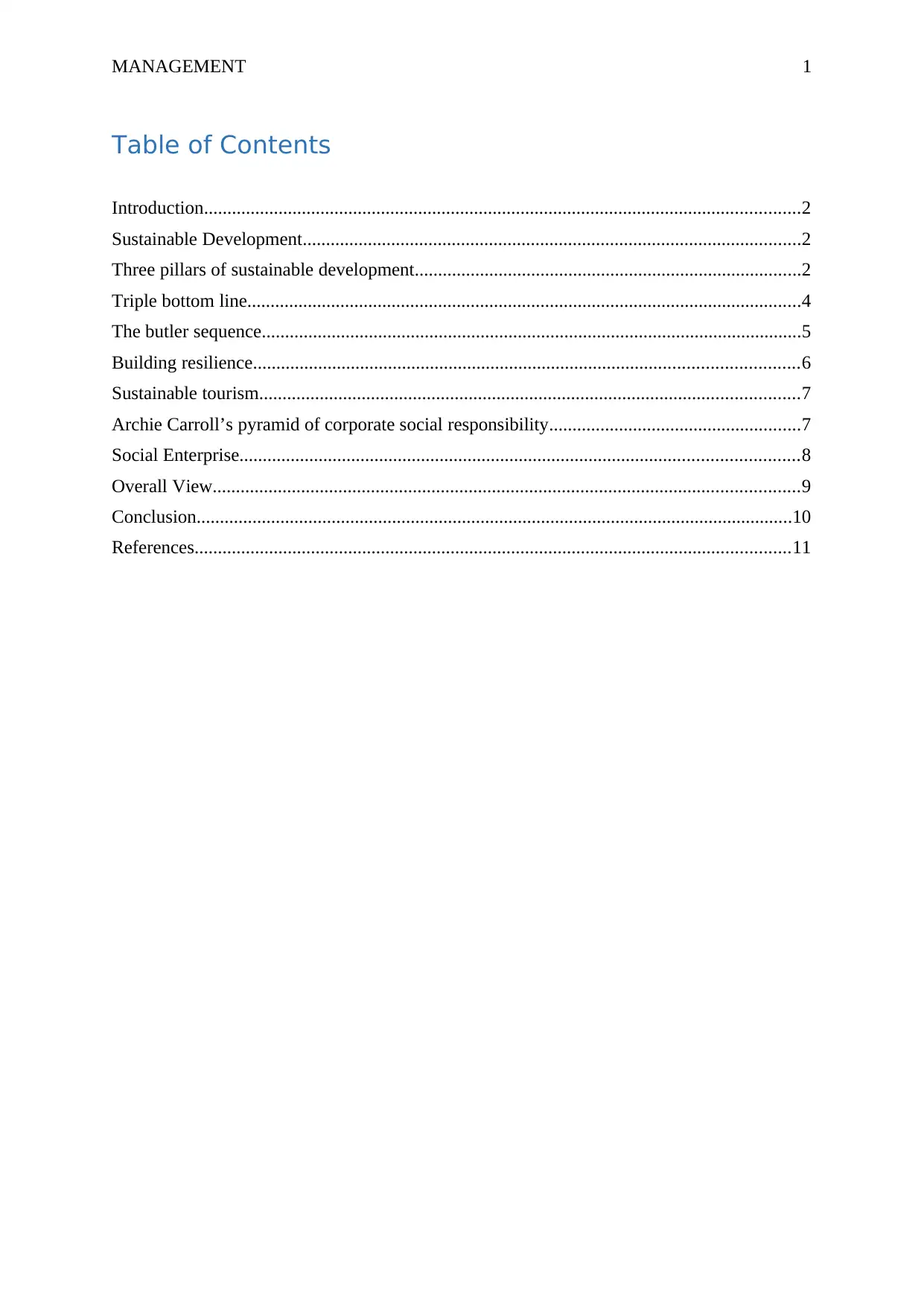
MANAGEMENT 1
Table of Contents
Introduction................................................................................................................................2
Sustainable Development...........................................................................................................2
Three pillars of sustainable development...................................................................................2
Triple bottom line.......................................................................................................................4
The butler sequence....................................................................................................................5
Building resilience.....................................................................................................................6
Sustainable tourism....................................................................................................................7
Archie Carroll’s pyramid of corporate social responsibility......................................................7
Social Enterprise........................................................................................................................8
Overall View..............................................................................................................................9
Conclusion................................................................................................................................10
References................................................................................................................................11
Table of Contents
Introduction................................................................................................................................2
Sustainable Development...........................................................................................................2
Three pillars of sustainable development...................................................................................2
Triple bottom line.......................................................................................................................4
The butler sequence....................................................................................................................5
Building resilience.....................................................................................................................6
Sustainable tourism....................................................................................................................7
Archie Carroll’s pyramid of corporate social responsibility......................................................7
Social Enterprise........................................................................................................................8
Overall View..............................................................................................................................9
Conclusion................................................................................................................................10
References................................................................................................................................11
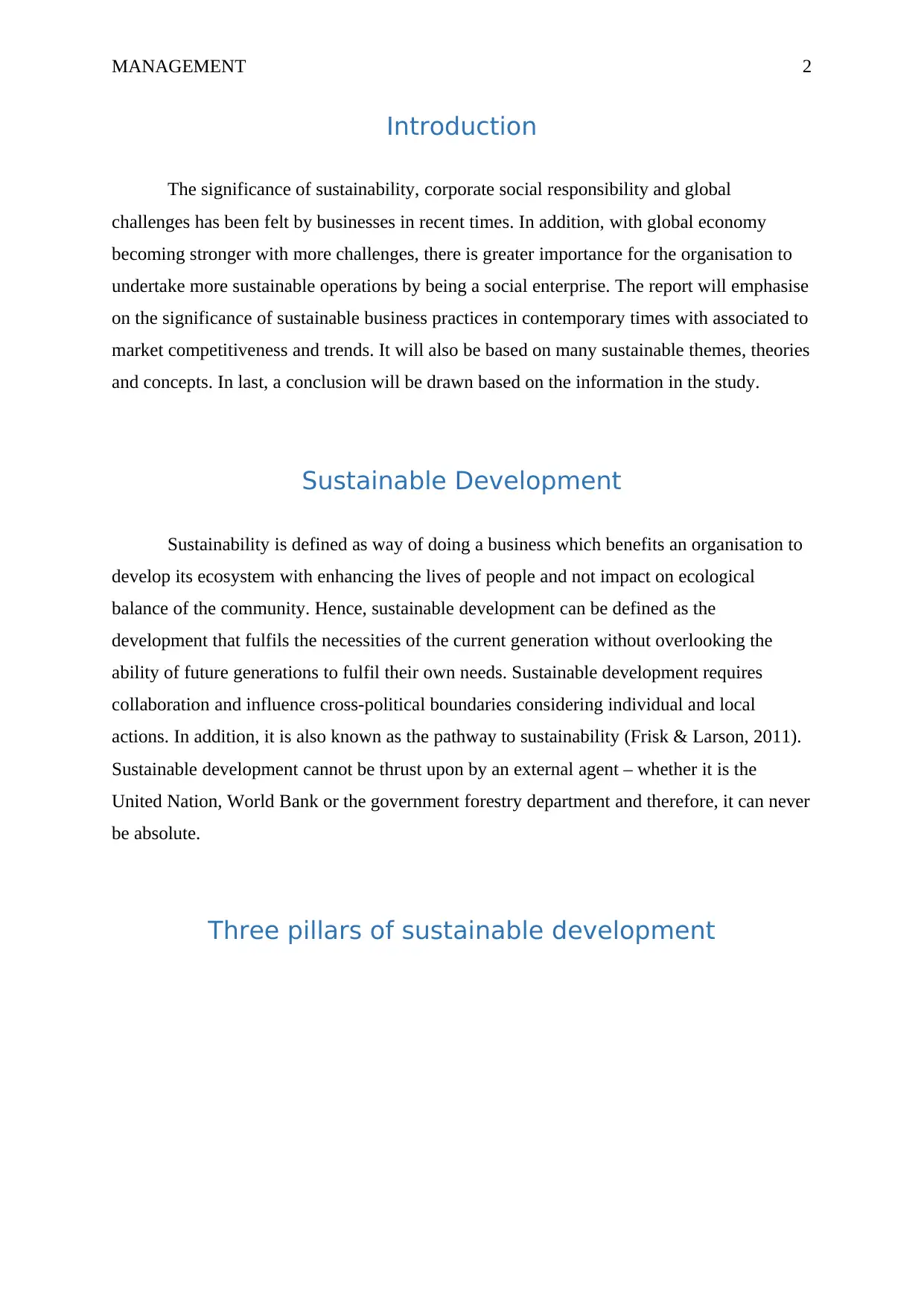
MANAGEMENT 2
Introduction
The significance of sustainability, corporate social responsibility and global
challenges has been felt by businesses in recent times. In addition, with global economy
becoming stronger with more challenges, there is greater importance for the organisation to
undertake more sustainable operations by being a social enterprise. The report will emphasise
on the significance of sustainable business practices in contemporary times with associated to
market competitiveness and trends. It will also be based on many sustainable themes, theories
and concepts. In last, a conclusion will be drawn based on the information in the study.
Sustainable Development
Sustainability is defined as way of doing a business which benefits an organisation to
develop its ecosystem with enhancing the lives of people and not impact on ecological
balance of the community. Hence, sustainable development can be defined as the
development that fulfils the necessities of the current generation without overlooking the
ability of future generations to fulfil their own needs. Sustainable development requires
collaboration and influence cross-political boundaries considering individual and local
actions. In addition, it is also known as the pathway to sustainability (Frisk & Larson, 2011).
Sustainable development cannot be thrust upon by an external agent – whether it is the
United Nation, World Bank or the government forestry department and therefore, it can never
be absolute.
Three pillars of sustainable development
Introduction
The significance of sustainability, corporate social responsibility and global
challenges has been felt by businesses in recent times. In addition, with global economy
becoming stronger with more challenges, there is greater importance for the organisation to
undertake more sustainable operations by being a social enterprise. The report will emphasise
on the significance of sustainable business practices in contemporary times with associated to
market competitiveness and trends. It will also be based on many sustainable themes, theories
and concepts. In last, a conclusion will be drawn based on the information in the study.
Sustainable Development
Sustainability is defined as way of doing a business which benefits an organisation to
develop its ecosystem with enhancing the lives of people and not impact on ecological
balance of the community. Hence, sustainable development can be defined as the
development that fulfils the necessities of the current generation without overlooking the
ability of future generations to fulfil their own needs. Sustainable development requires
collaboration and influence cross-political boundaries considering individual and local
actions. In addition, it is also known as the pathway to sustainability (Frisk & Larson, 2011).
Sustainable development cannot be thrust upon by an external agent – whether it is the
United Nation, World Bank or the government forestry department and therefore, it can never
be absolute.
Three pillars of sustainable development
⊘ This is a preview!⊘
Do you want full access?
Subscribe today to unlock all pages.

Trusted by 1+ million students worldwide
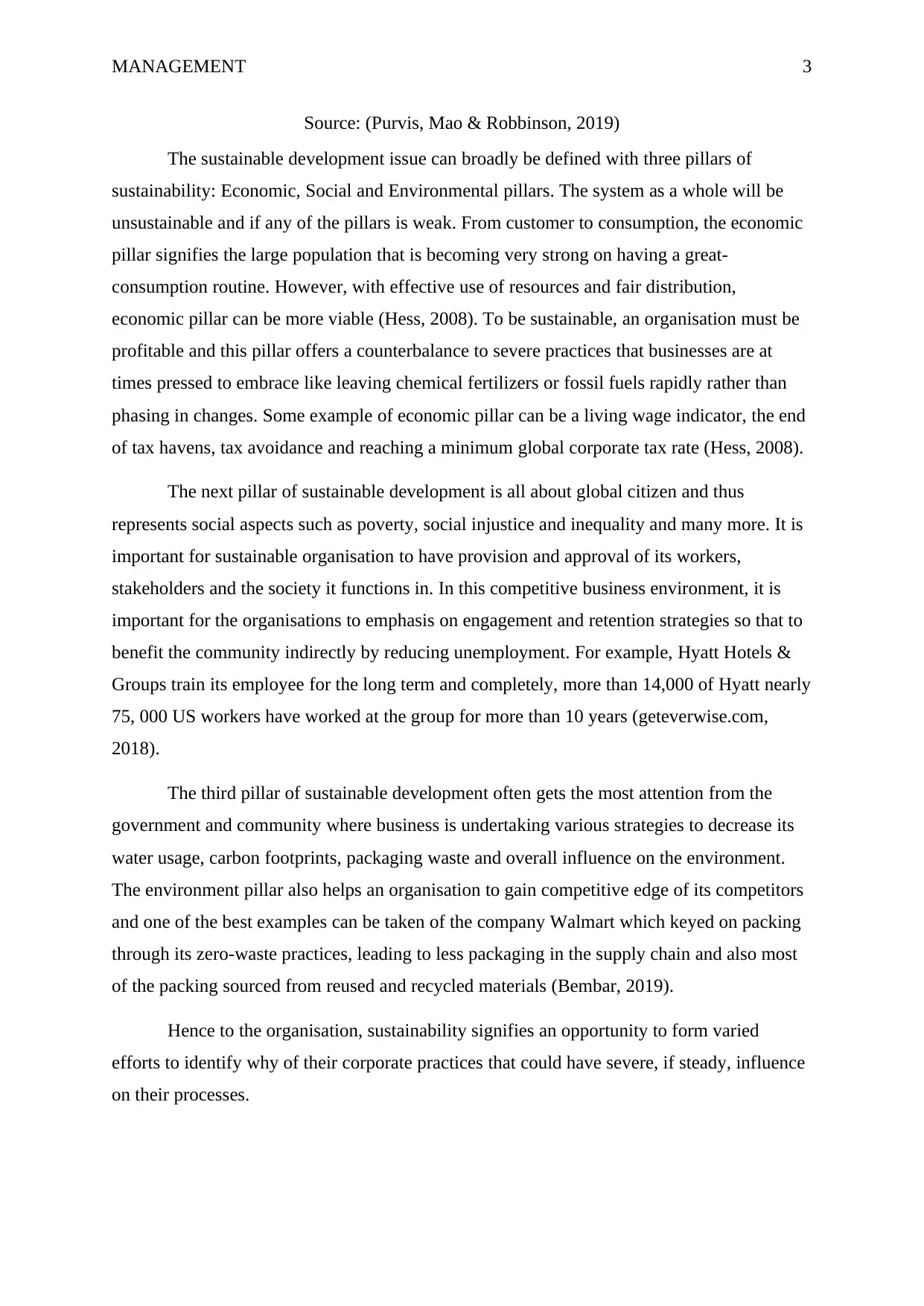
MANAGEMENT 3
Source: (Purvis, Mao & Robbinson, 2019)
The sustainable development issue can broadly be defined with three pillars of
sustainability: Economic, Social and Environmental pillars. The system as a whole will be
unsustainable and if any of the pillars is weak. From customer to consumption, the economic
pillar signifies the large population that is becoming very strong on having a great-
consumption routine. However, with effective use of resources and fair distribution,
economic pillar can be more viable (Hess, 2008). To be sustainable, an organisation must be
profitable and this pillar offers a counterbalance to severe practices that businesses are at
times pressed to embrace like leaving chemical fertilizers or fossil fuels rapidly rather than
phasing in changes. Some example of economic pillar can be a living wage indicator, the end
of tax havens, tax avoidance and reaching a minimum global corporate tax rate (Hess, 2008).
The next pillar of sustainable development is all about global citizen and thus
represents social aspects such as poverty, social injustice and inequality and many more. It is
important for sustainable organisation to have provision and approval of its workers,
stakeholders and the society it functions in. In this competitive business environment, it is
important for the organisations to emphasis on engagement and retention strategies so that to
benefit the community indirectly by reducing unemployment. For example, Hyatt Hotels &
Groups train its employee for the long term and completely, more than 14,000 of Hyatt nearly
75, 000 US workers have worked at the group for more than 10 years (geteverwise.com,
2018).
The third pillar of sustainable development often gets the most attention from the
government and community where business is undertaking various strategies to decrease its
water usage, carbon footprints, packaging waste and overall influence on the environment.
The environment pillar also helps an organisation to gain competitive edge of its competitors
and one of the best examples can be taken of the company Walmart which keyed on packing
through its zero-waste practices, leading to less packaging in the supply chain and also most
of the packing sourced from reused and recycled materials (Bembar, 2019).
Hence to the organisation, sustainability signifies an opportunity to form varied
efforts to identify why of their corporate practices that could have severe, if steady, influence
on their processes.
Source: (Purvis, Mao & Robbinson, 2019)
The sustainable development issue can broadly be defined with three pillars of
sustainability: Economic, Social and Environmental pillars. The system as a whole will be
unsustainable and if any of the pillars is weak. From customer to consumption, the economic
pillar signifies the large population that is becoming very strong on having a great-
consumption routine. However, with effective use of resources and fair distribution,
economic pillar can be more viable (Hess, 2008). To be sustainable, an organisation must be
profitable and this pillar offers a counterbalance to severe practices that businesses are at
times pressed to embrace like leaving chemical fertilizers or fossil fuels rapidly rather than
phasing in changes. Some example of economic pillar can be a living wage indicator, the end
of tax havens, tax avoidance and reaching a minimum global corporate tax rate (Hess, 2008).
The next pillar of sustainable development is all about global citizen and thus
represents social aspects such as poverty, social injustice and inequality and many more. It is
important for sustainable organisation to have provision and approval of its workers,
stakeholders and the society it functions in. In this competitive business environment, it is
important for the organisations to emphasis on engagement and retention strategies so that to
benefit the community indirectly by reducing unemployment. For example, Hyatt Hotels &
Groups train its employee for the long term and completely, more than 14,000 of Hyatt nearly
75, 000 US workers have worked at the group for more than 10 years (geteverwise.com,
2018).
The third pillar of sustainable development often gets the most attention from the
government and community where business is undertaking various strategies to decrease its
water usage, carbon footprints, packaging waste and overall influence on the environment.
The environment pillar also helps an organisation to gain competitive edge of its competitors
and one of the best examples can be taken of the company Walmart which keyed on packing
through its zero-waste practices, leading to less packaging in the supply chain and also most
of the packing sourced from reused and recycled materials (Bembar, 2019).
Hence to the organisation, sustainability signifies an opportunity to form varied
efforts to identify why of their corporate practices that could have severe, if steady, influence
on their processes.
Paraphrase This Document
Need a fresh take? Get an instant paraphrase of this document with our AI Paraphraser
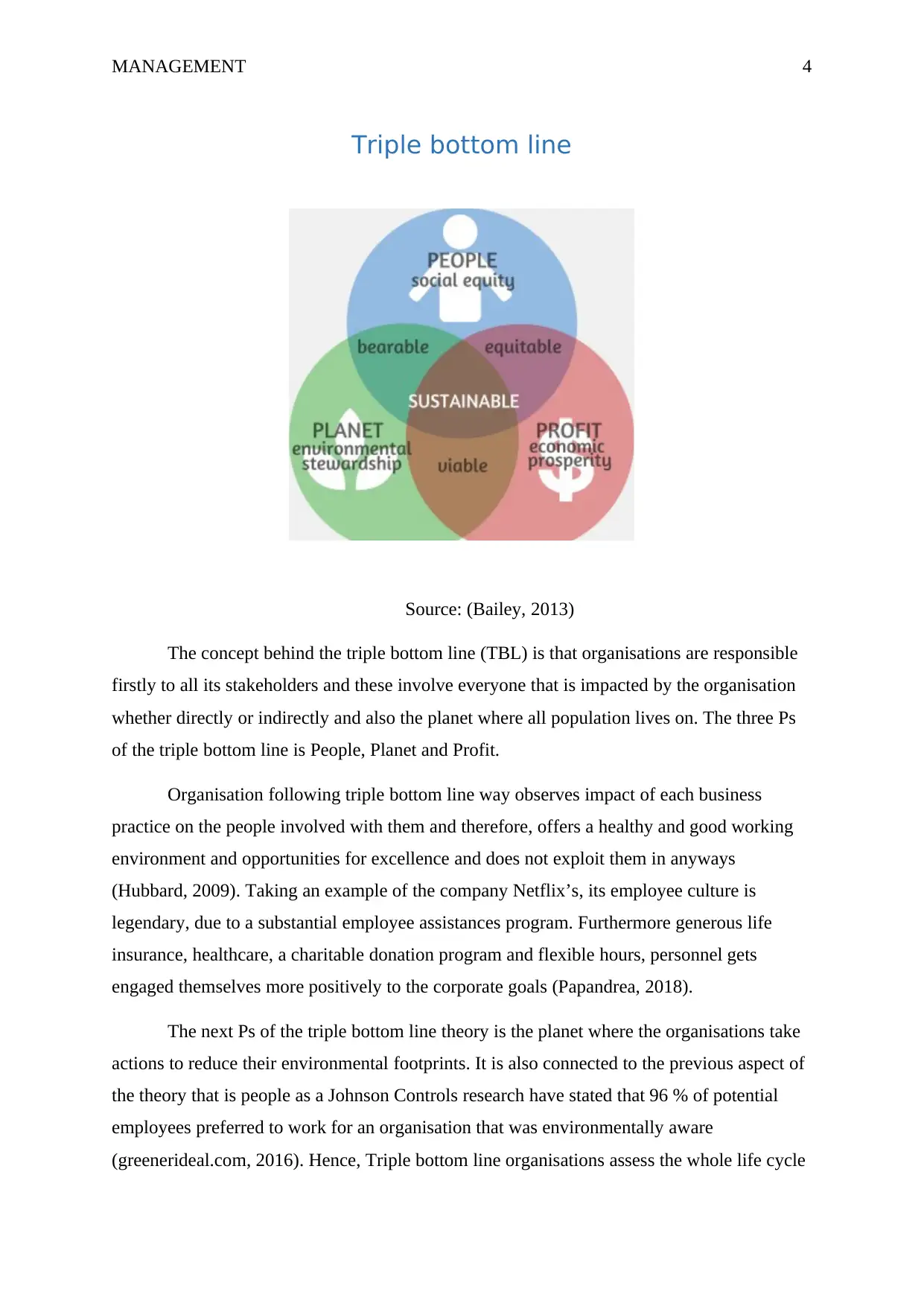
MANAGEMENT 4
Triple bottom line
Source: (Bailey, 2013)
The concept behind the triple bottom line (TBL) is that organisations are responsible
firstly to all its stakeholders and these involve everyone that is impacted by the organisation
whether directly or indirectly and also the planet where all population lives on. The three Ps
of the triple bottom line is People, Planet and Profit.
Organisation following triple bottom line way observes impact of each business
practice on the people involved with them and therefore, offers a healthy and good working
environment and opportunities for excellence and does not exploit them in anyways
(Hubbard, 2009). Taking an example of the company Netflix’s, its employee culture is
legendary, due to a substantial employee assistances program. Furthermore generous life
insurance, healthcare, a charitable donation program and flexible hours, personnel gets
engaged themselves more positively to the corporate goals (Papandrea, 2018).
The next Ps of the triple bottom line theory is the planet where the organisations take
actions to reduce their environmental footprints. It is also connected to the previous aspect of
the theory that is people as a Johnson Controls research have stated that 96 % of potential
employees preferred to work for an organisation that was environmentally aware
(greenerideal.com, 2016). Hence, Triple bottom line organisations assess the whole life cycle
Triple bottom line
Source: (Bailey, 2013)
The concept behind the triple bottom line (TBL) is that organisations are responsible
firstly to all its stakeholders and these involve everyone that is impacted by the organisation
whether directly or indirectly and also the planet where all population lives on. The three Ps
of the triple bottom line is People, Planet and Profit.
Organisation following triple bottom line way observes impact of each business
practice on the people involved with them and therefore, offers a healthy and good working
environment and opportunities for excellence and does not exploit them in anyways
(Hubbard, 2009). Taking an example of the company Netflix’s, its employee culture is
legendary, due to a substantial employee assistances program. Furthermore generous life
insurance, healthcare, a charitable donation program and flexible hours, personnel gets
engaged themselves more positively to the corporate goals (Papandrea, 2018).
The next Ps of the triple bottom line theory is the planet where the organisations take
actions to reduce their environmental footprints. It is also connected to the previous aspect of
the theory that is people as a Johnson Controls research have stated that 96 % of potential
employees preferred to work for an organisation that was environmentally aware
(greenerideal.com, 2016). Hence, Triple bottom line organisations assess the whole life cycle
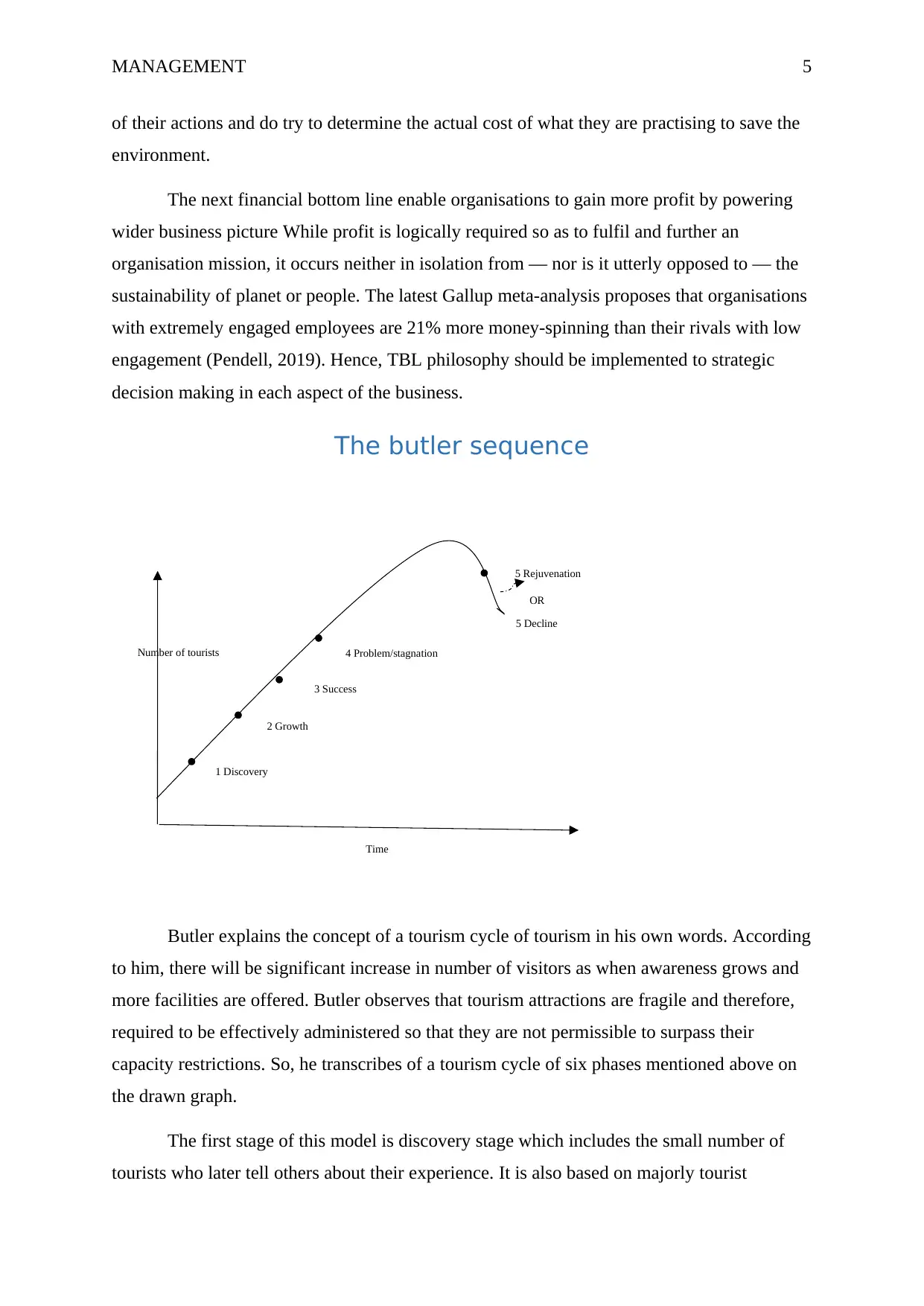
MANAGEMENT 5
of their actions and do try to determine the actual cost of what they are practising to save the
environment.
The next financial bottom line enable organisations to gain more profit by powering
wider business picture While profit is logically required so as to fulfil and further an
organisation mission, it occurs neither in isolation from — nor is it utterly opposed to — the
sustainability of planet or people. The latest Gallup meta-analysis proposes that organisations
with extremely engaged employees are 21% more money-spinning than their rivals with low
engagement (Pendell, 2019). Hence, TBL philosophy should be implemented to strategic
decision making in each aspect of the business.
The butler sequence
Butler explains the concept of a tourism cycle of tourism in his own words. According
to him, there will be significant increase in number of visitors as when awareness grows and
more facilities are offered. Butler observes that tourism attractions are fragile and therefore,
required to be effectively administered so that they are not permissible to surpass their
capacity restrictions. So, he transcribes of a tourism cycle of six phases mentioned above on
the drawn graph.
The first stage of this model is discovery stage which includes the small number of
tourists who later tell others about their experience. It is also based on majorly tourist
1 Discovery
2 Growth
3 Success
4 Problem/stagnation
5 Rejuvenation
5 Decline
OR
Time
Number of tourists
of their actions and do try to determine the actual cost of what they are practising to save the
environment.
The next financial bottom line enable organisations to gain more profit by powering
wider business picture While profit is logically required so as to fulfil and further an
organisation mission, it occurs neither in isolation from — nor is it utterly opposed to — the
sustainability of planet or people. The latest Gallup meta-analysis proposes that organisations
with extremely engaged employees are 21% more money-spinning than their rivals with low
engagement (Pendell, 2019). Hence, TBL philosophy should be implemented to strategic
decision making in each aspect of the business.
The butler sequence
Butler explains the concept of a tourism cycle of tourism in his own words. According
to him, there will be significant increase in number of visitors as when awareness grows and
more facilities are offered. Butler observes that tourism attractions are fragile and therefore,
required to be effectively administered so that they are not permissible to surpass their
capacity restrictions. So, he transcribes of a tourism cycle of six phases mentioned above on
the drawn graph.
The first stage of this model is discovery stage which includes the small number of
tourists who later tell others about their experience. It is also based on majorly tourist
1 Discovery
2 Growth
3 Success
4 Problem/stagnation
5 Rejuvenation
5 Decline
OR
Time
Number of tourists
⊘ This is a preview!⊘
Do you want full access?
Subscribe today to unlock all pages.

Trusted by 1+ million students worldwide
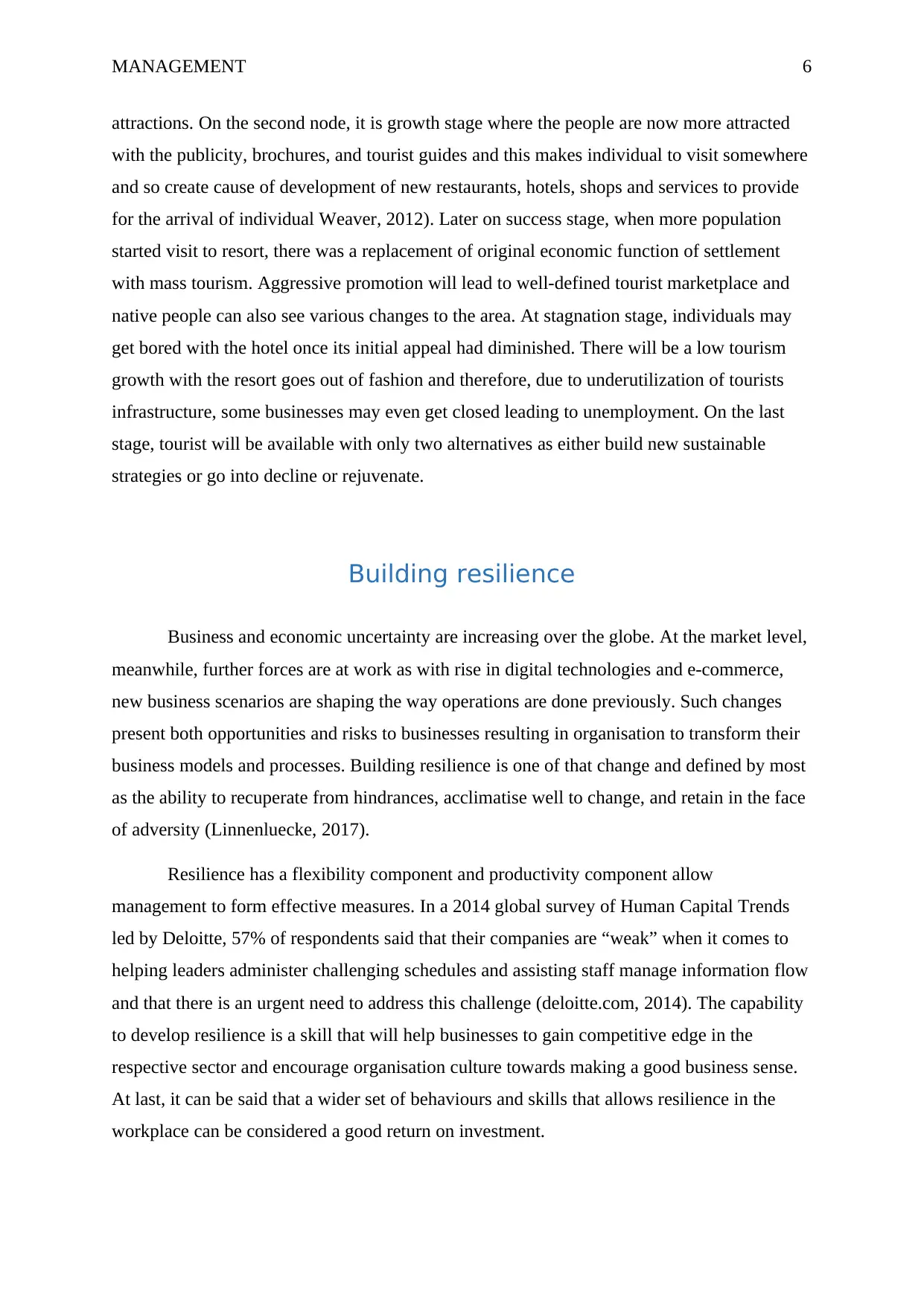
MANAGEMENT 6
attractions. On the second node, it is growth stage where the people are now more attracted
with the publicity, brochures, and tourist guides and this makes individual to visit somewhere
and so create cause of development of new restaurants, hotels, shops and services to provide
for the arrival of individual Weaver, 2012). Later on success stage, when more population
started visit to resort, there was a replacement of original economic function of settlement
with mass tourism. Aggressive promotion will lead to well-defined tourist marketplace and
native people can also see various changes to the area. At stagnation stage, individuals may
get bored with the hotel once its initial appeal had diminished. There will be a low tourism
growth with the resort goes out of fashion and therefore, due to underutilization of tourists
infrastructure, some businesses may even get closed leading to unemployment. On the last
stage, tourist will be available with only two alternatives as either build new sustainable
strategies or go into decline or rejuvenate.
Building resilience
Business and economic uncertainty are increasing over the globe. At the market level,
meanwhile, further forces are at work as with rise in digital technologies and e-commerce,
new business scenarios are shaping the way operations are done previously. Such changes
present both opportunities and risks to businesses resulting in organisation to transform their
business models and processes. Building resilience is one of that change and defined by most
as the ability to recuperate from hindrances, acclimatise well to change, and retain in the face
of adversity (Linnenluecke, 2017).
Resilience has a flexibility component and productivity component allow
management to form effective measures. In a 2014 global survey of Human Capital Trends
led by Deloitte, 57% of respondents said that their companies are “weak” when it comes to
helping leaders administer challenging schedules and assisting staff manage information flow
and that there is an urgent need to address this challenge (deloitte.com, 2014). The capability
to develop resilience is a skill that will help businesses to gain competitive edge in the
respective sector and encourage organisation culture towards making a good business sense.
At last, it can be said that a wider set of behaviours and skills that allows resilience in the
workplace can be considered a good return on investment.
attractions. On the second node, it is growth stage where the people are now more attracted
with the publicity, brochures, and tourist guides and this makes individual to visit somewhere
and so create cause of development of new restaurants, hotels, shops and services to provide
for the arrival of individual Weaver, 2012). Later on success stage, when more population
started visit to resort, there was a replacement of original economic function of settlement
with mass tourism. Aggressive promotion will lead to well-defined tourist marketplace and
native people can also see various changes to the area. At stagnation stage, individuals may
get bored with the hotel once its initial appeal had diminished. There will be a low tourism
growth with the resort goes out of fashion and therefore, due to underutilization of tourists
infrastructure, some businesses may even get closed leading to unemployment. On the last
stage, tourist will be available with only two alternatives as either build new sustainable
strategies or go into decline or rejuvenate.
Building resilience
Business and economic uncertainty are increasing over the globe. At the market level,
meanwhile, further forces are at work as with rise in digital technologies and e-commerce,
new business scenarios are shaping the way operations are done previously. Such changes
present both opportunities and risks to businesses resulting in organisation to transform their
business models and processes. Building resilience is one of that change and defined by most
as the ability to recuperate from hindrances, acclimatise well to change, and retain in the face
of adversity (Linnenluecke, 2017).
Resilience has a flexibility component and productivity component allow
management to form effective measures. In a 2014 global survey of Human Capital Trends
led by Deloitte, 57% of respondents said that their companies are “weak” when it comes to
helping leaders administer challenging schedules and assisting staff manage information flow
and that there is an urgent need to address this challenge (deloitte.com, 2014). The capability
to develop resilience is a skill that will help businesses to gain competitive edge in the
respective sector and encourage organisation culture towards making a good business sense.
At last, it can be said that a wider set of behaviours and skills that allows resilience in the
workplace can be considered a good return on investment.
Paraphrase This Document
Need a fresh take? Get an instant paraphrase of this document with our AI Paraphraser
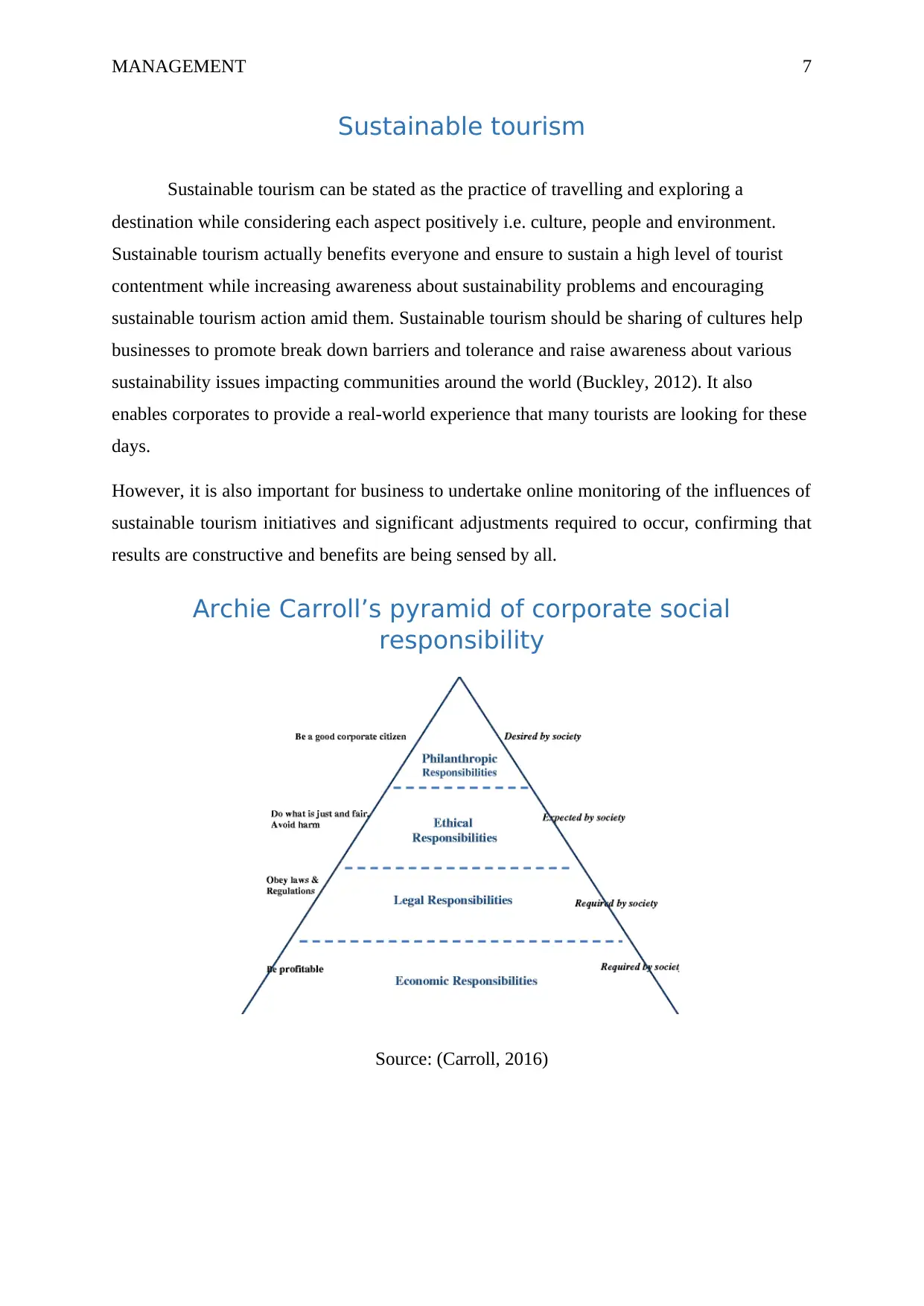
MANAGEMENT 7
Sustainable tourism
Sustainable tourism can be stated as the practice of travelling and exploring a
destination while considering each aspect positively i.e. culture, people and environment.
Sustainable tourism actually benefits everyone and ensure to sustain a high level of tourist
contentment while increasing awareness about sustainability problems and encouraging
sustainable tourism action amid them. Sustainable tourism should be sharing of cultures help
businesses to promote break down barriers and tolerance and raise awareness about various
sustainability issues impacting communities around the world (Buckley, 2012). It also
enables corporates to provide a real-world experience that many tourists are looking for these
days.
However, it is also important for business to undertake online monitoring of the influences of
sustainable tourism initiatives and significant adjustments required to occur, confirming that
results are constructive and benefits are being sensed by all.
Archie Carroll’s pyramid of corporate social
responsibility
Source: (Carroll, 2016)
Sustainable tourism
Sustainable tourism can be stated as the practice of travelling and exploring a
destination while considering each aspect positively i.e. culture, people and environment.
Sustainable tourism actually benefits everyone and ensure to sustain a high level of tourist
contentment while increasing awareness about sustainability problems and encouraging
sustainable tourism action amid them. Sustainable tourism should be sharing of cultures help
businesses to promote break down barriers and tolerance and raise awareness about various
sustainability issues impacting communities around the world (Buckley, 2012). It also
enables corporates to provide a real-world experience that many tourists are looking for these
days.
However, it is also important for business to undertake online monitoring of the influences of
sustainable tourism initiatives and significant adjustments required to occur, confirming that
results are constructive and benefits are being sensed by all.
Archie Carroll’s pyramid of corporate social
responsibility
Source: (Carroll, 2016)
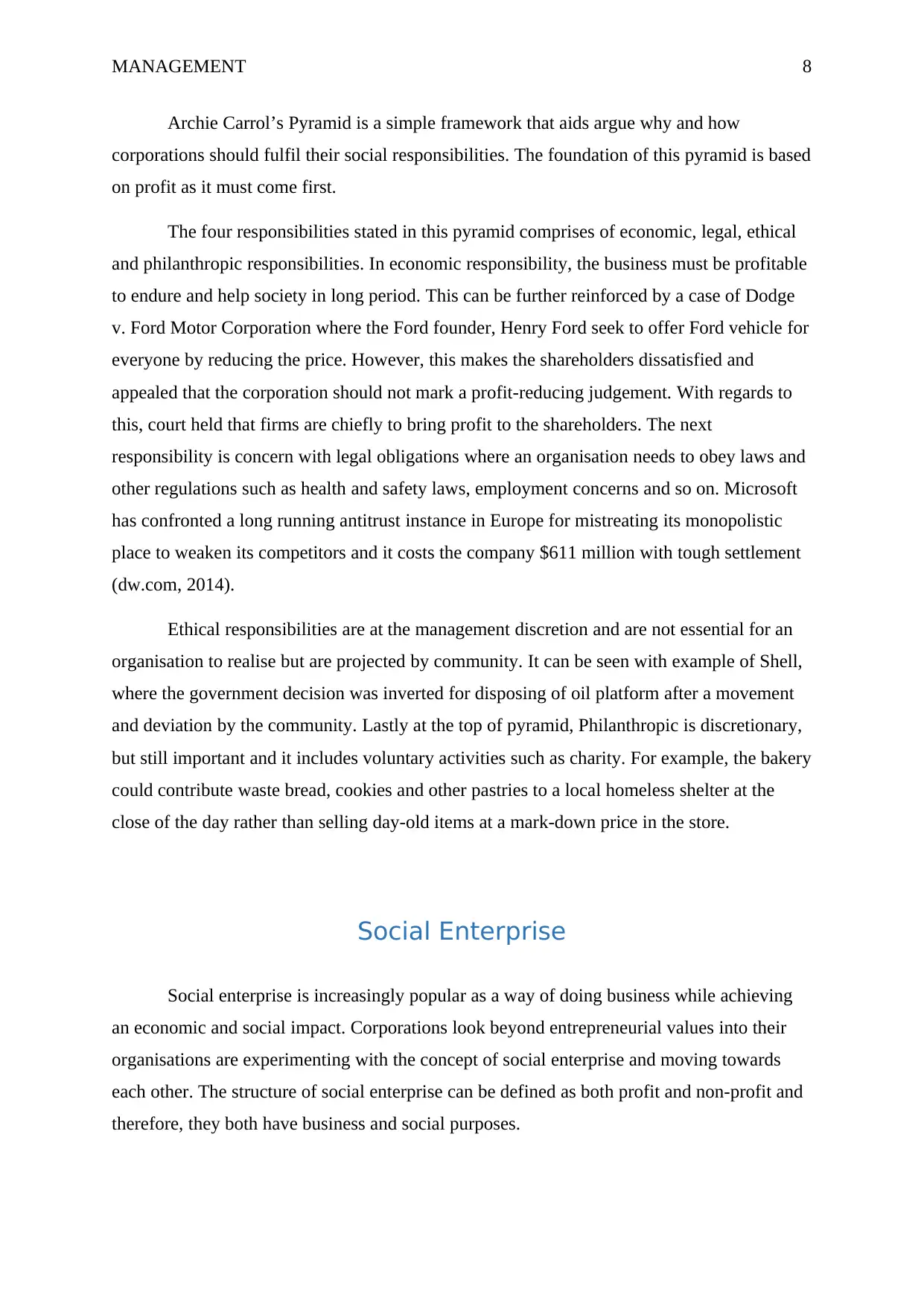
MANAGEMENT 8
Archie Carrol’s Pyramid is a simple framework that aids argue why and how
corporations should fulfil their social responsibilities. The foundation of this pyramid is based
on profit as it must come first.
The four responsibilities stated in this pyramid comprises of economic, legal, ethical
and philanthropic responsibilities. In economic responsibility, the business must be profitable
to endure and help society in long period. This can be further reinforced by a case of Dodge
v. Ford Motor Corporation where the Ford founder, Henry Ford seek to offer Ford vehicle for
everyone by reducing the price. However, this makes the shareholders dissatisfied and
appealed that the corporation should not mark a profit-reducing judgement. With regards to
this, court held that firms are chiefly to bring profit to the shareholders. The next
responsibility is concern with legal obligations where an organisation needs to obey laws and
other regulations such as health and safety laws, employment concerns and so on. Microsoft
has confronted a long running antitrust instance in Europe for mistreating its monopolistic
place to weaken its competitors and it costs the company $611 million with tough settlement
(dw.com, 2014).
Ethical responsibilities are at the management discretion and are not essential for an
organisation to realise but are projected by community. It can be seen with example of Shell,
where the government decision was inverted for disposing of oil platform after a movement
and deviation by the community. Lastly at the top of pyramid, Philanthropic is discretionary,
but still important and it includes voluntary activities such as charity. For example, the bakery
could contribute waste bread, cookies and other pastries to a local homeless shelter at the
close of the day rather than selling day-old items at a mark-down price in the store.
Social Enterprise
Social enterprise is increasingly popular as a way of doing business while achieving
an economic and social impact. Corporations look beyond entrepreneurial values into their
organisations are experimenting with the concept of social enterprise and moving towards
each other. The structure of social enterprise can be defined as both profit and non-profit and
therefore, they both have business and social purposes.
Archie Carrol’s Pyramid is a simple framework that aids argue why and how
corporations should fulfil their social responsibilities. The foundation of this pyramid is based
on profit as it must come first.
The four responsibilities stated in this pyramid comprises of economic, legal, ethical
and philanthropic responsibilities. In economic responsibility, the business must be profitable
to endure and help society in long period. This can be further reinforced by a case of Dodge
v. Ford Motor Corporation where the Ford founder, Henry Ford seek to offer Ford vehicle for
everyone by reducing the price. However, this makes the shareholders dissatisfied and
appealed that the corporation should not mark a profit-reducing judgement. With regards to
this, court held that firms are chiefly to bring profit to the shareholders. The next
responsibility is concern with legal obligations where an organisation needs to obey laws and
other regulations such as health and safety laws, employment concerns and so on. Microsoft
has confronted a long running antitrust instance in Europe for mistreating its monopolistic
place to weaken its competitors and it costs the company $611 million with tough settlement
(dw.com, 2014).
Ethical responsibilities are at the management discretion and are not essential for an
organisation to realise but are projected by community. It can be seen with example of Shell,
where the government decision was inverted for disposing of oil platform after a movement
and deviation by the community. Lastly at the top of pyramid, Philanthropic is discretionary,
but still important and it includes voluntary activities such as charity. For example, the bakery
could contribute waste bread, cookies and other pastries to a local homeless shelter at the
close of the day rather than selling day-old items at a mark-down price in the store.
Social Enterprise
Social enterprise is increasingly popular as a way of doing business while achieving
an economic and social impact. Corporations look beyond entrepreneurial values into their
organisations are experimenting with the concept of social enterprise and moving towards
each other. The structure of social enterprise can be defined as both profit and non-profit and
therefore, they both have business and social purposes.
⊘ This is a preview!⊘
Do you want full access?
Subscribe today to unlock all pages.

Trusted by 1+ million students worldwide
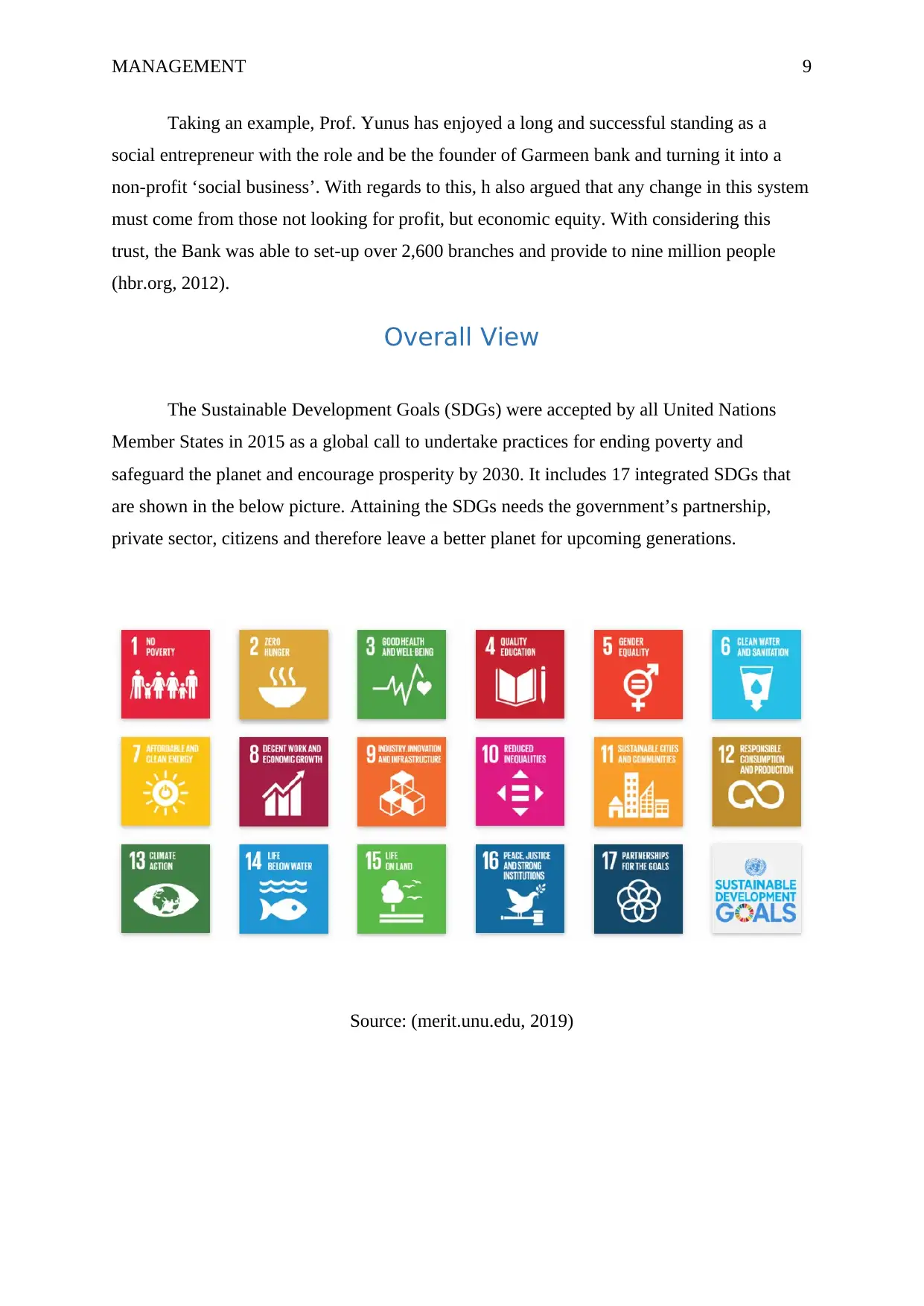
MANAGEMENT 9
Taking an example, Prof. Yunus has enjoyed a long and successful standing as a
social entrepreneur with the role and be the founder of Garmeen bank and turning it into a
non-profit ‘social business’. With regards to this, h also argued that any change in this system
must come from those not looking for profit, but economic equity. With considering this
trust, the Bank was able to set-up over 2,600 branches and provide to nine million people
(hbr.org, 2012).
Overall View
The Sustainable Development Goals (SDGs) were accepted by all United Nations
Member States in 2015 as a global call to undertake practices for ending poverty and
safeguard the planet and encourage prosperity by 2030. It includes 17 integrated SDGs that
are shown in the below picture. Attaining the SDGs needs the government’s partnership,
private sector, citizens and therefore leave a better planet for upcoming generations.
Source: (merit.unu.edu, 2019)
Taking an example, Prof. Yunus has enjoyed a long and successful standing as a
social entrepreneur with the role and be the founder of Garmeen bank and turning it into a
non-profit ‘social business’. With regards to this, h also argued that any change in this system
must come from those not looking for profit, but economic equity. With considering this
trust, the Bank was able to set-up over 2,600 branches and provide to nine million people
(hbr.org, 2012).
Overall View
The Sustainable Development Goals (SDGs) were accepted by all United Nations
Member States in 2015 as a global call to undertake practices for ending poverty and
safeguard the planet and encourage prosperity by 2030. It includes 17 integrated SDGs that
are shown in the below picture. Attaining the SDGs needs the government’s partnership,
private sector, citizens and therefore leave a better planet for upcoming generations.
Source: (merit.unu.edu, 2019)
Paraphrase This Document
Need a fresh take? Get an instant paraphrase of this document with our AI Paraphraser
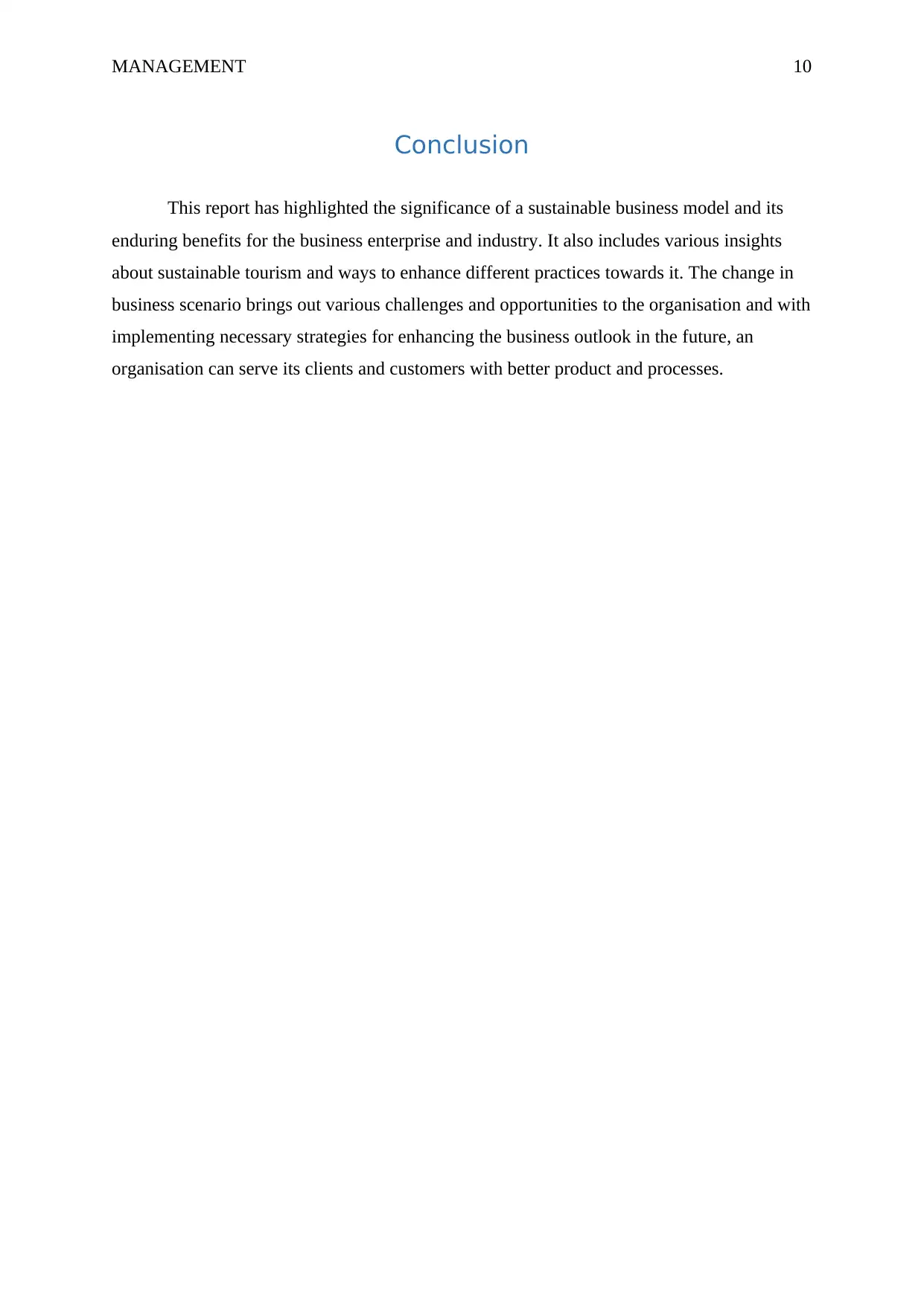
MANAGEMENT 10
Conclusion
This report has highlighted the significance of a sustainable business model and its
enduring benefits for the business enterprise and industry. It also includes various insights
about sustainable tourism and ways to enhance different practices towards it. The change in
business scenario brings out various challenges and opportunities to the organisation and with
implementing necessary strategies for enhancing the business outlook in the future, an
organisation can serve its clients and customers with better product and processes.
Conclusion
This report has highlighted the significance of a sustainable business model and its
enduring benefits for the business enterprise and industry. It also includes various insights
about sustainable tourism and ways to enhance different practices towards it. The change in
business scenario brings out various challenges and opportunities to the organisation and with
implementing necessary strategies for enhancing the business outlook in the future, an
organisation can serve its clients and customers with better product and processes.
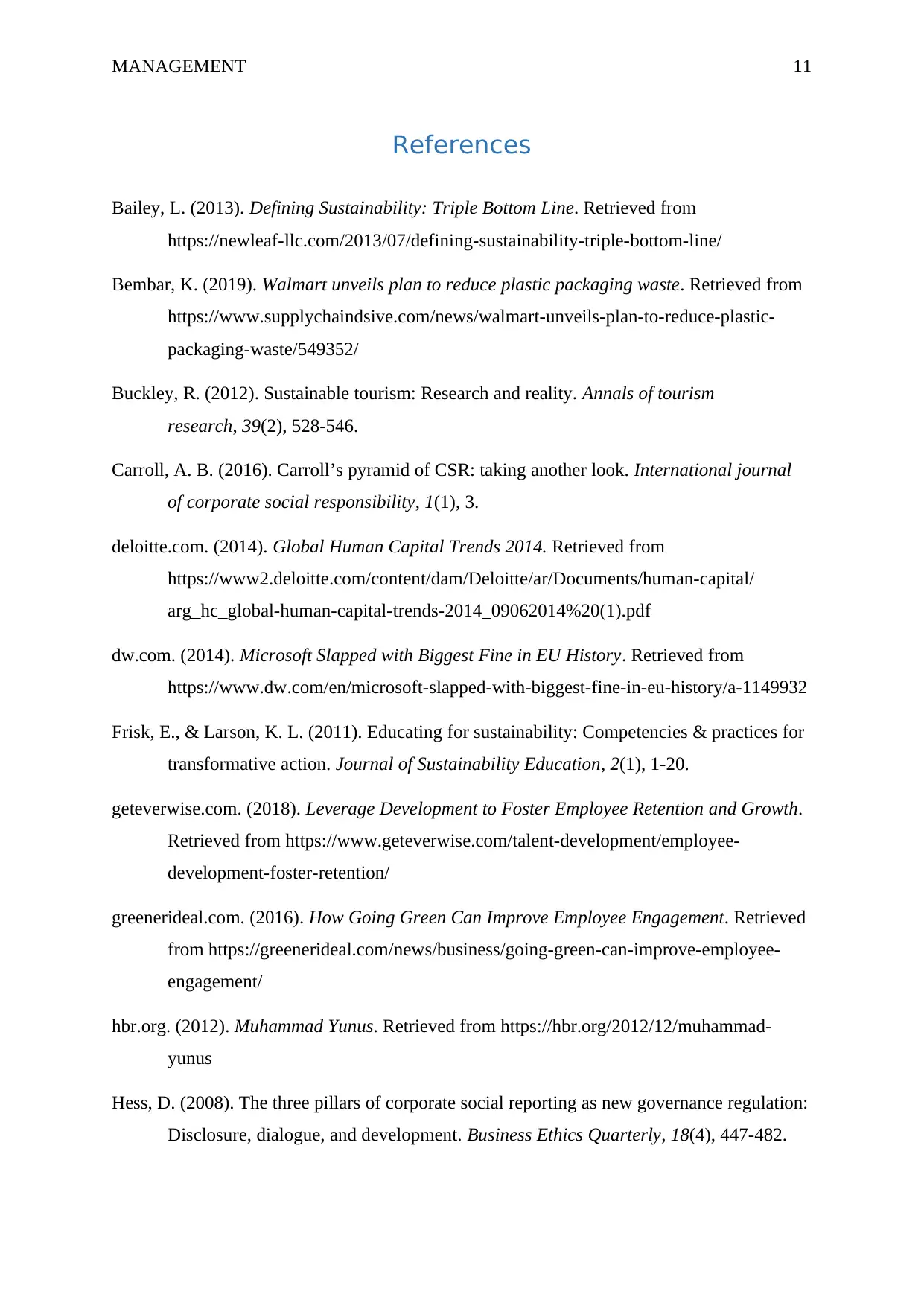
MANAGEMENT 11
References
Bailey, L. (2013). Defining Sustainability: Triple Bottom Line. Retrieved from
https://newleaf-llc.com/2013/07/defining-sustainability-triple-bottom-line/
Bembar, K. (2019). Walmart unveils plan to reduce plastic packaging waste. Retrieved from
https://www.supplychaindsive.com/news/walmart-unveils-plan-to-reduce-plastic-
packaging-waste/549352/
Buckley, R. (2012). Sustainable tourism: Research and reality. Annals of tourism
research, 39(2), 528-546.
Carroll, A. B. (2016). Carroll’s pyramid of CSR: taking another look. International journal
of corporate social responsibility, 1(1), 3.
deloitte.com. (2014). Global Human Capital Trends 2014. Retrieved from
https://www2.deloitte.com/content/dam/Deloitte/ar/Documents/human-capital/
arg_hc_global-human-capital-trends-2014_09062014%20(1).pdf
dw.com. (2014). Microsoft Slapped with Biggest Fine in EU History. Retrieved from
https://www.dw.com/en/microsoft-slapped-with-biggest-fine-in-eu-history/a-1149932
Frisk, E., & Larson, K. L. (2011). Educating for sustainability: Competencies & practices for
transformative action. Journal of Sustainability Education, 2(1), 1-20.
geteverwise.com. (2018). Leverage Development to Foster Employee Retention and Growth.
Retrieved from https://www.geteverwise.com/talent-development/employee-
development-foster-retention/
greenerideal.com. (2016). How Going Green Can Improve Employee Engagement. Retrieved
from https://greenerideal.com/news/business/going-green-can-improve-employee-
engagement/
hbr.org. (2012). Muhammad Yunus. Retrieved from https://hbr.org/2012/12/muhammad-
yunus
Hess, D. (2008). The three pillars of corporate social reporting as new governance regulation:
Disclosure, dialogue, and development. Business Ethics Quarterly, 18(4), 447-482.
References
Bailey, L. (2013). Defining Sustainability: Triple Bottom Line. Retrieved from
https://newleaf-llc.com/2013/07/defining-sustainability-triple-bottom-line/
Bembar, K. (2019). Walmart unveils plan to reduce plastic packaging waste. Retrieved from
https://www.supplychaindsive.com/news/walmart-unveils-plan-to-reduce-plastic-
packaging-waste/549352/
Buckley, R. (2012). Sustainable tourism: Research and reality. Annals of tourism
research, 39(2), 528-546.
Carroll, A. B. (2016). Carroll’s pyramid of CSR: taking another look. International journal
of corporate social responsibility, 1(1), 3.
deloitte.com. (2014). Global Human Capital Trends 2014. Retrieved from
https://www2.deloitte.com/content/dam/Deloitte/ar/Documents/human-capital/
arg_hc_global-human-capital-trends-2014_09062014%20(1).pdf
dw.com. (2014). Microsoft Slapped with Biggest Fine in EU History. Retrieved from
https://www.dw.com/en/microsoft-slapped-with-biggest-fine-in-eu-history/a-1149932
Frisk, E., & Larson, K. L. (2011). Educating for sustainability: Competencies & practices for
transformative action. Journal of Sustainability Education, 2(1), 1-20.
geteverwise.com. (2018). Leverage Development to Foster Employee Retention and Growth.
Retrieved from https://www.geteverwise.com/talent-development/employee-
development-foster-retention/
greenerideal.com. (2016). How Going Green Can Improve Employee Engagement. Retrieved
from https://greenerideal.com/news/business/going-green-can-improve-employee-
engagement/
hbr.org. (2012). Muhammad Yunus. Retrieved from https://hbr.org/2012/12/muhammad-
yunus
Hess, D. (2008). The three pillars of corporate social reporting as new governance regulation:
Disclosure, dialogue, and development. Business Ethics Quarterly, 18(4), 447-482.
⊘ This is a preview!⊘
Do you want full access?
Subscribe today to unlock all pages.

Trusted by 1+ million students worldwide
1 out of 13
Related Documents
Your All-in-One AI-Powered Toolkit for Academic Success.
+13062052269
info@desklib.com
Available 24*7 on WhatsApp / Email
![[object Object]](/_next/static/media/star-bottom.7253800d.svg)
Unlock your academic potential
Copyright © 2020–2025 A2Z Services. All Rights Reserved. Developed and managed by ZUCOL.





